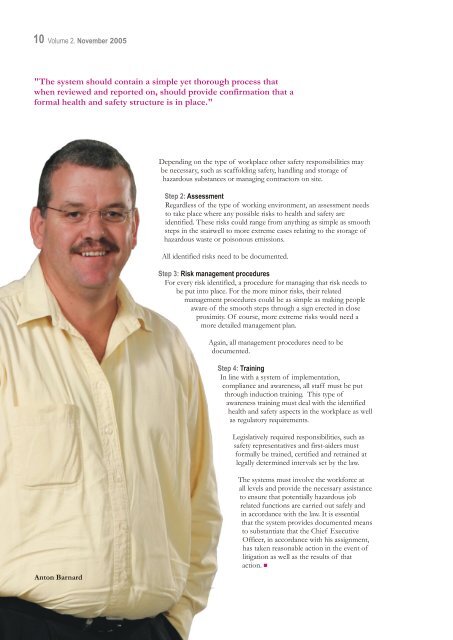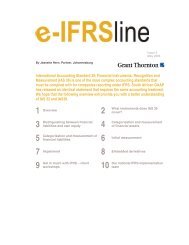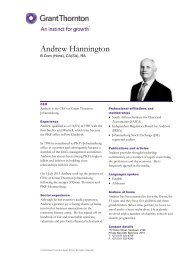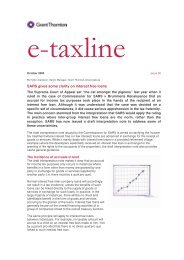IFRS - there's nowhere to hide - Grant Thornton
IFRS - there's nowhere to hide - Grant Thornton
IFRS - there's nowhere to hide - Grant Thornton
You also want an ePaper? Increase the reach of your titles
YUMPU automatically turns print PDFs into web optimized ePapers that Google loves.
10 Volume 2. November 2005<br />
"The system should contain a simple yet thorough process that<br />
when reviewed and reported on, should provide confirmation that a<br />
formal health and safety structure is in place."<br />
Depending on the type of workplace other safety responsibilities may<br />
be necessary, such as scaffolding safety, handling and s<strong>to</strong>rage of<br />
hazardous substances or managing contrac<strong>to</strong>rs on site.<br />
Step 2: Assessment<br />
Regardless of the type of working environment, an assessment needs<br />
<strong>to</strong> take place where any possible risks <strong>to</strong> health and safety are<br />
identified. These risks could range from anything as simple as smooth<br />
steps in the stairwell <strong>to</strong> more extreme cases relating <strong>to</strong> the s<strong>to</strong>rage of<br />
hazardous waste or poisonous emissions.<br />
All identified risks need <strong>to</strong> be documented.<br />
Step 3: Risk management procedures<br />
For every risk identified, a procedure for managing that risk needs <strong>to</strong><br />
be put in<strong>to</strong> place. For the more minor risks, their related<br />
management procedures could be as simple as making people<br />
aware of the smooth steps through a sign erected in close<br />
proximity. Of course, more extreme risks would need a<br />
more detailed management plan.<br />
Again, all management procedures need <strong>to</strong> be<br />
documented.<br />
Step 4: Training<br />
In line with a system of implementation,<br />
compliance and awareness, all staff must be put<br />
through induction training. This type of<br />
awareness training must deal with the identified<br />
health and safety aspects in the workplace as well<br />
as regula<strong>to</strong>ry requirements.<br />
Legislatively required responsibilities, such as<br />
safety representatives and first-aiders must<br />
formally be trained, certified and retrained at<br />
legally determined intervals set by the law.<br />
An<strong>to</strong>n Barnard<br />
The systems must involve the workforce at<br />
all levels and provide the necessary assistance<br />
<strong>to</strong> ensure that potentially hazardous job<br />
related functions are carried out safely and<br />
in accordance with the law. It is essential<br />
that the system provides documented means<br />
<strong>to</strong> substantiate that the Chief Executive<br />
Officer, in accordance with his assignment,<br />
has taken reasonable action in the event of<br />
litigation as well as the results of that<br />
action.










